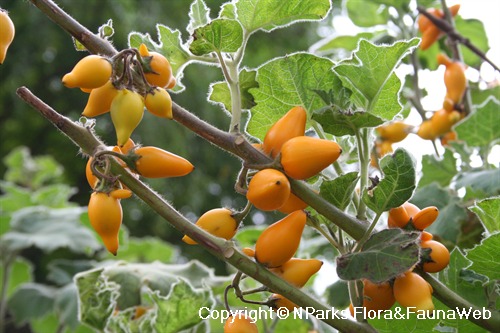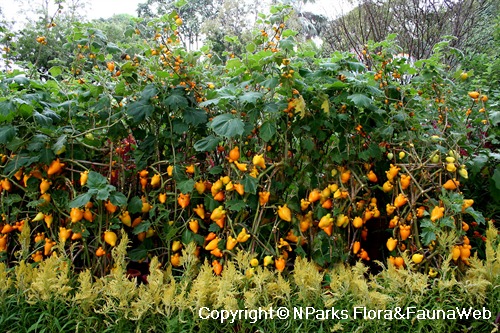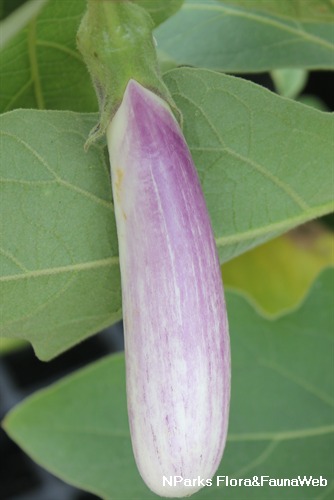
Back
Solanum mammosum L.
| Family Name: | Solanaceae |
| Common Name: | Nipple Fruit, Cow's Udder Plant, Lady Nipples, Five-finger Fruit, Macaw Bush, Titty Fruit, Apple of Sodom, Nipple Nightshade, 乳茄, 五代同堂, 五指茄, 真奇之果 |
Name
Classifications and Characteristics
| Plant Division | Angiosperms (Flowering Seed Plants) (Dicotyledon) |
|---|---|
| Plant Growth Form | Herbaceous Plant |
| Lifespan (in Singapore) | Perennial, Semi-Annual / Annual-Like, Annual |
| Mode of Nutrition | Autotrophic |
| Plant Shape | Shrubby |
| Maximum Height | 0.6 m to 1.8 m |
Biogeography
| Native Distribution | Mexico, Carribean, tropical South America |
|---|---|
| Native Habitat | Terrestrial (Disturbed Area / Open Ground) |
| Preferred Climate Zone | Tropical |
Description and Ethnobotany
| Others - Plant Morphology | Perennial herbaceous shrub, sometimes used as annual. Grows up to 1.8m tall and somewhat coarse-looking. Stems densely covered with fine glandular hairs, and may have thorns.Leaves broadly-lobed, velvety, armed with spiny recurved prickles on major veins on upper and lower surface. Flowers star-shaped, with furry purple petals and yellow centres, produced in clusters of 3 to 4. Fruits are pear-shaped berries with nipple-like protrusions and spongy white mesocarp, ripen from green to yellow to orange, contain numerous reddish-brown to dark brown flattened seeds covered with purplish mucilage.Usually grown for unusual ornamental fruits, which are toxic if ingested. Pefers well-drained soils rich in organic matter. Propagate by seeds or cuttings. |
|---|---|
| Ethnobotanical Uses | Food (Herb or Spice) Others: Branches of ripe fruits used in floral arrangements. Mucilaginous fruit sap may be used as natural detergent. Fruits also used as cockroach poison and repellent against leaf cutter ants. Fruits symbolize good luck and often used as festive decor during Lunar New Year. Also used as religious offering in Taiwan. Ripe fruits used medicinally in homeopathic remedies, and said to be effective against skin diseases like athlete's foot and to soothe nervousness and irritability. |
Landscaping Features
| Desirable Plant Features | Ornamental Flowers, Ornamental Fruits |
|---|---|
| Landscape Uses | Flowerbed / Border, Focal Plant, Container Planting |
| Thematic Landscaping | Golden Garden, Economic Garden |
| Usage Hazard - Cons | Spines/Thorns - Stem/Branch, Spines/Thorns - Leaf, Toxic Upon Ingestion |
| Usage Hazard - Cons Remarks | Leaves covered with spiny prickles on adaxial and abaxial veins. Stems may also be armed with recurved spines. Fruits are toxic if eaten. |
Plant Care and Propagation
| Light Preference | Full Sun |
|---|---|
| Water Preference | Moderate Water |
| Plant Growth Rate | Moderate |
| Rootzone Tolerance | Fertile Loamy Soils, Well-Drained Soils |
| Maintenance Requirements | Moderate |
| Propagation Method | Seed, Stem Cutting |
Foliar
| Foliage Retention | Evergreen |
|---|---|
| Mature Foliage Colour(s) | Green |
| Mature Foliage Texture(s) | Velvety / Furry / Tomentose, Hairy / Hirsute, Spiny / Bristly / Stinging |
| Foliar Modification | Spine (axillary), Prickle / Emergence (blade) |
| Foliar Type | Simple / Unifoliate |
| Foliar Arrangement Along Stem | Whorled |
| Foliar Shape(s) | Non-Palm Foliage (Obovate, Oval) |
| Foliar Venation | Pinnate / Net |
| Foliar Margin | Dentate |
| Foliar Apex - Tip | Acute |
| Foliar Base | Truncate / Square |
| Typical Foliar Area | Mesophyll ( 45cm2 - 182.25 cm2 ) |
Non - Foliar and Storage
| Stem Type & Modification | Herbaceous |
|---|---|
| Root Type | Underground (Fibrous Root) |
Floral (Angiosperm)
| Flower & Plant Sexuality | Bisexual Flowers |
| Flower Colour(s) | Purple, Yellow / Golden |
|---|---|
| Flower Symmetry | Radial |
| Individual Flower Shape | Stellate / Star-shaped |
| Flowering Habit | Polycarpic |
Fruit, Seed and Spore
| Mature Fruit Colour(s) | Orange |
|---|---|
| Fruit Classification | Simple Fruit |
| Fruit Type | Fleshy Fruit , Berry |
Image Repository
Others
| Master ID | 1165 |
|---|---|
| Species ID | 2458 |
| Flora Disclaimer | The information in this website has been compiled from reliable sources, such as reference works on medicinal plants. It is not a substitute for medical advice or treatment and NParks does not purport to provide any medical advice. Readers should always consult his/her physician before using or consuming a plant for medicinal purposes. |











